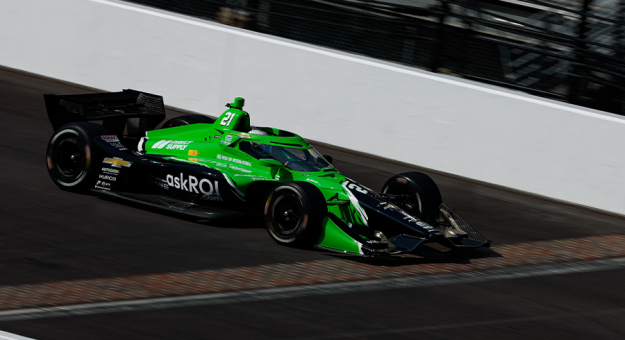A two-day test at the Indianapolis Motor Speedway Road Course was conducted last week, allowing more NTT IndyCar Series teams to get a feel for the new hybrid engine, which the series hopes to roll out after May’s Indianapolis 500.
The 2.2-liter twin turbo direct-injected V6 Chevrolet and Honda engines with hybrid technology were tested by Rahal Letterman Lanigan Racing, Meyer Shank Racing, A.J. Foyt Racing, Juncos Hollinger Racing, Ed Carpenter Racing and Dale Coyne Racing.
After countless miles of on-track action, drivers spoke highly of the technology.
“I love it. For my driving style in particular, it’s a huge help for me, the way you can control it to rotate the car,” Santino Ferrucci, driver of the No. 14 A.J. Foyt Racing Chevrolet said. “I’m a very oversteer-happy, rear-end happy kind of driver.
“My current issue with the car we have now, especially since we’ve put all the weight up top, has been when you come off the brakes and roll into the speed, the weight creates a massive understeer and front wash. I’ve really struggled to obviously adapt. It’s one of my Achilles heels.”
For Ferrucci, the hybrid system allows for him to showcase his talents inside the cockpit.
“Having the hybrid system in is so much better, plus it’s really fun because it adds a depth to the driving and being able to think,” Ferrucci said. “You have the hybrid system and the overtake system, you have the way you’re regenerating, so many different things that I feel like it’s making it more of a drivers’ car.
“The series is already so tight between having this car for so long, setups for every team are pretty good across the board, to add another aspect to where the driver can make a difference is huge.”
The verdict around the paddock during the two-day session was the hybrid system allows for drivers to have more control.
With additional horsepower and added push-to-pass, it allows for the skillset of drivers to be more prevalent.
A.J. Foyt Racing’s Sting Ray Robb feels the changes could also promote more strategies in races.
“It’s a matter of how you regen (hybrid regenerate), how much you regen, and how much you deploy,” Robb said. “It seems to be similar in the sense of push-to-pass when you’re at lower speeds. When you’re at maximum velocity, it doesn’t have a lot of help. I’m interested to see what it’s like with the push-to-pass.
“I think with those two complimenting each other, and maybe trying to supplement one or the other to save one or the other during a race might be useful. I think that it could change the racing, but at the same time, everyone has the same package to work with so it will be who uses it the wisest.”
Automatic Starters
A key point with the hybrid system is the opportunity for drivers to now have a self-starter in their race car. Currently, whether in the pits before going out on track or if a car stalls on the race track, the need for an external starter was needed to engage the engine and refire it.
ECR’s Rinus VeeKay had a comical moment in the pits during testing.
“The guys were a lot happier, and they were all cheering,” VeeKay said. “It’s basically a toggle I put to the side, and it fires up.”
How might the hybrid system add difficulty for the drivers?
Ferrucci believes the tool will force drivers to prepare in a different way with the added hybrid element.
“You’re really using it as a balancing tool, and the energy they’re giving you for a lap, it’s a lot of work to be using it every lap, depleting it and reusing it, you’re very busy mentally driving the car, not just physically anymore,” Ferrucci said.
“So I think the races are now very long, very difficult, adding this step is going to add to driver fatigue and you’re going to have to train extra hard on everything that you do.
“It just needs to become second nature.”
